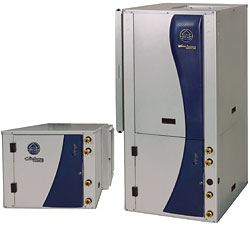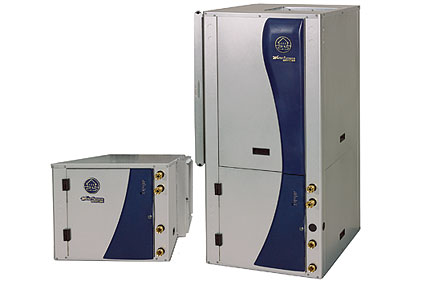 For many in the HVAC industry, this is not the first time they have been involved with renewable energy technologies like solar and geothermal systems. For those who worked in the 1970s and early 80s, there is an air of déjà vu. An important thing to bear in mind, say some, is the improvement in comfort in addition to cost.
For many in the HVAC industry, this is not the first time they have been involved with renewable energy technologies like solar and geothermal systems. For those who worked in the 1970s and early 80s, there is an air of déjà vu. An important thing to bear in mind, say some, is the improvement in comfort in addition to cost.
Steve Howard, president of The ACT Group Inc., Phoenix, said he recently had thought about “the rebate-driven solar industry during the Carter administration. My crystal ball says long term, every industry must be able to prosper wholly within the boundaries of the free enterprise system.” He has seen what happens when rebates influence the market too heavily.
On the other hand, “We in the HVAC industry are very fortunate that the reason consumers buy our product is that they want to be comfortable,” he said. “Rebates for smart contractors are just frosting on the cake.
“Contractors who carry the right products and have customer-focused sales skills have been very successful in good economies and bad for the last years without subsidies, rebates, or government giveaways.”
Sales of renewable technologies are typically “all about ROI,” he said.
“But you don’t need ROI on a/c because you also have comfort. We don’t get the same pleasure out of the ROI as we do out of comfort, nor the peace of mind (sleeping better, healthier). They’re selling Btus and Watts; the consumers just care about which is the cheapest cost.” Comfort and peace of mind can tip the decision in the contractor’s favor.
Even with geothermal systems, “We’re not selling Btus, we’re selling comfort,” Howard said. “People are buying it for a totally different reason today.
“The gypsies sell rebates,” he added; “smart contractors sell comfort. Part of that is financial comfort, but it’s trumped by physical and emotional comfort. The wonderful thing is that working with builders, high efficiency is built into the home and 30-year mortgage — just another line item.”
More Competition
Tim Litton, WaterFurnace director of marketing, said that “in addition to technological advancements (variable-speed compressors, coax and loop research, communicating technology), there are a number of other important trends. Because of increasing interest levels in geothermal, there’s been increased competition in the industry. The number of brands available to consumers is much greater than it was 10 years ago.”
From contractor and consumer perspectives, “that’s great news,” he said. “Competition is a primary motivator for companies to provide better services and products to win market share ... we’re passionate about being the best company with which to do business on the contractor side, and about building a brand that homeowners connect with on the consumer side.”
At the policy level, “Most of the major manufacturers have demonstrated their commitment to the success of the industry by uniting behind the Geothermal Exchange Organization (GEO),” Litton said. “GEO was created to represent our interests on Capitol Hill, and to be an advocate for the industry. GEO members have all dedicated valuable resources to help further that cause for everyone, even nonmembers.”
Geothermal is growing at an impressive rate, he said, “Although, there is still a lot of room to grow. Currently the technology represents less than 2 percent of the total market.”
In Europe, he said, “Geothermal makes up around 20 percent of the market and provides a glimpse into the potential for the United States. In fact, according to a new report from Pike Research, geothermal heat pump sales are expected to experience strong growth rates in the next several years, with annual unit shipments in the United States increasing from just fewer than 150,000 in 2011, to more than 326,000 units by 2017.”
While federal tax credits can help overcome the initial price barrier and stimulate the technology’s adoption, Litton said the industry had already been growing for a number of years without them. “That’s because geothermal has historically been financially viable even without incentives.”
Acceptance
Interest has been growing among consumers and contractors because geothermal provides strong benefits to both, Litton said. “Contractors enjoy a product that provides healthy margins, a strong selling proposition, and a myriad of benefits to the local community. Together they provide a nice synergy.”
According to Jim Wiff, director of engineering for GeoSystems, LLC, “Regulatory requirements continue to drive improvements in product performance and narrow the playing field. Qualification for the 30 percent tax credit is dependent on meeting these performance requirements.
“For the industry as a whole, our two greatest challenges are consumer awareness, and first cost associated with initial installation. The tax credit goes a long way toward helping overcome that first-cost challenge, enabling the industry to advance even in today’s uncertain economic environment.
“While that tax credit is critical,” he said, “we expect to see continued advancement in heat pump and loop field technologies that will help reduce first cost of installation in the future.”
Contractor’s View
For commercial mechanical contractor Southland Industries, sustainability and renewable technologies are “a huge thing for us,” said Rick Ellison, manager of energy and modeling. “All of our projects, almost every one of them, has some sort of energy goal. We go through all the trades to make sure we meet goals.”
Green projects are “the biggest part of the business,” he said. “All the fed government projects have to be LEED, and GSA is the largest local owner of real estate. It’s driven through clients and regulations. It takes mandates to go against the cheapest,” Ellison commented.
A lot of financing is available, he said. “One project got a $1.3 million rebate; we transformed a LEED model into one that could be used by the utility for financing. However, when regulations drive customers more than energy costs, they tend to set short-sighted goals. Consider up to 40-year payback if it’s the right thing to do.”
www.geosystemsghp.com
www.southlandind.com
www.waterfurnace.com
Publication date: 08/29/2011


Report Abusive Comment